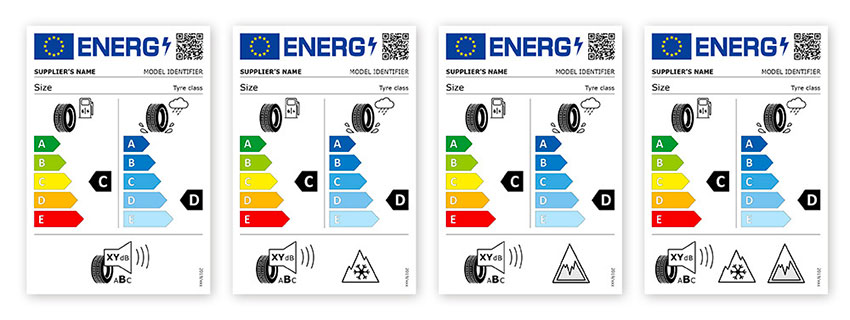The tyre energy label allows drivers to check not only that they are buying the right tyre for their vehicle, but also to find out about its different performances in terms of wet braking, external rolling noise and rolling resistance. It also encourages tyre manufacturers to develop quieter, safer and more efficient models.
Tyre performance classification
Three separate energy labels are used to classify tyres and their performance:
- Ranging from the most efficient to the least efficient and rated from A to G, the energy efficiency class now offers the possibility to see the rolling resistance performance of the tyre, and therefore the energy it needs. The less rolling resistant a tyre has, the less energy it will take to move, which can result in significant savings.
- Also ranging from A to G according to the same rule as the previous point, the wet grip class is used to determine the braking distance in wet conditions.
- To evaluate the noise level, the external noise producedis noted on this label with A or B (highest to lowest). Note that tyres of noise level class C are no longer allowed.

The energy label and the law
Initially provided for in Regulation (EC) No 1222/2009, the obligation to provide energy labelled car and van tyres on the European market is replaced by Regulation (EU) 2020/740 from 1 May 2021. The new requirements of the changed regulation also apply to trucks and buses.
In addition, this new energy label regulation requires that a symbol indicating the tyre's performance in terms of grip in extreme snow and ice conditions be placed on the tyre in addition to the standard label. This increases the number of labelling options to four. If the tyre is a Nordic winter tyre, it will have the icy mountain symbol, while if it is suitable for extreme snow conditions, it will have the alpine symbol represented by the 3-Peak-Mountain-SnowFlake image.
In addition, the new energy requirement symbols more explicitly indicate that fuel efficiency applies to both electric and internal combustion vehicles. The noise performance class will always be indicated on the lower part of the tyre by displaying the noise level in decibels.
This new regulation also mentions the prohibition of tyre classes F and G for wet grip and rolling resistance. Thus, the scale of values changes to A to E, replacing the A to G scale, retaining just 5-class values.
Finally, tyres displaying the 5 different performances will be evaluated by standardised tests and the competent authorities may decide to carry out checks. It will also be possible to consult the European Commission's database by using the QR Code to obtain additional information. It should also be noted that with regard to the general safety of motor vehicles, that Regulation (EC) No 661/2009 sets minimum efficiency requirements for the ecodesign of tyres.
Correspondence between the old and new generation of energy labels:

